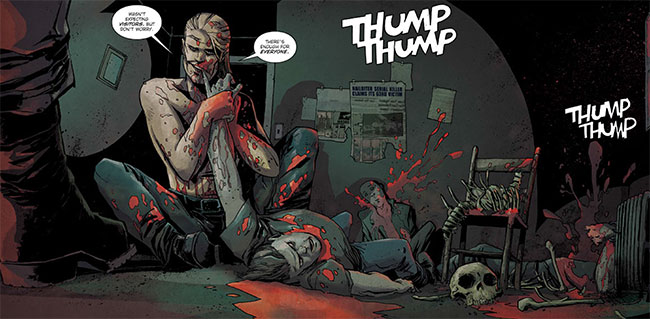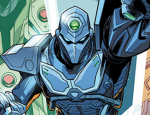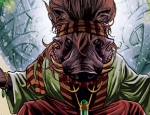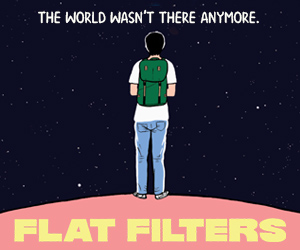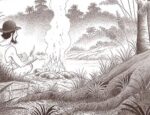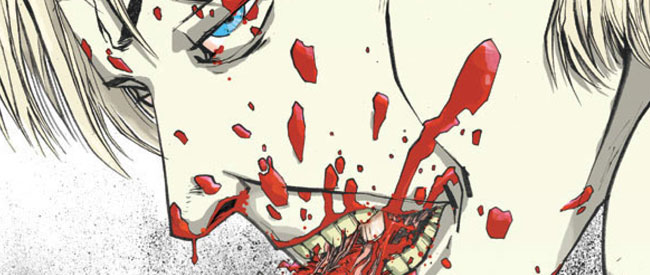 Joshua Williamson and Mike Henderson bring incredible individual talent to this dark, intriguing comic, but fall just short of a cohesive approach to storytelling.
Joshua Williamson and Mike Henderson bring incredible individual talent to this dark, intriguing comic, but fall just short of a cohesive approach to storytelling.
What makes a serial killer? Is it the result of childhood trauma? Is it a learned behaviour from bad societal influences like violent video games and films? Or are some people just born evil? For Eliot Carroll, the answer might be something more sinister.
Nailbiter #1 opens with Carroll leading a police bust on the residence of Edward “Nailbiter” Warren, a cannibalistic serial killer in Buckaroo, Oregon; a small town with a disturbing legacy. The town’s reputation is tarnished by a long lineage of local serial killers – 16 in total – colloquially referred to as the Buckeroo Butchers, of which Nailbiter was the most recent.
Three years later, Army Intelligence officer Nicholas Finch arrives in Buckaroo, called in by Carroll, who claims to have cracked the mystery behind the town’s legacy of serial murder. When the local sheriff informs Finch that Carroll has gone missing, the two decide to follow up on his investigation, forcing them to go to the unconscionably acquitted Nailbiter for assistance.
The story is wonderfully intriguing. It has elements of horror, mystery, and conspiracy woven all the way through and, like the story’s protagonists, it is difficult to resist wanting to learn everything about this town and these killers. Writer Joshua Williamson demonstrates an understanding that intrigue and suspense applies not only to a story’s content, but also its form. That is to say, the information provided to the reader is equally important to how and when it is provided.
Two of the Buckaroo Butchers are introduced in this issue: the Nailbiter and the Book Burner. The former is presented as the account laid out in a police report; the latter, on the other hand, is presented more in the vein of a ghost story. The Book Burner’s own grandson relates the story to Finch as he explains his curious serial killer souvenir shop. Where the Nailbiter’s story is presented as fact, the manner in which we learn about the Book Burner leaves the story open to interpretation.
How much of the story is exaggeration? Is the story even true? Can the Book Burner’s grandson be trusted? And that shift in narrative framing thrusts the reader into the position of Carroll, and by extension Finch – that is, of the conspiracy theorist attempting to decipher clues as to how these killers are connected.
Mike Henderson’s art contributes to this visceral experience of the story, especially through his panel layouts in the first four pages. Using his sound effects – specifically a pounding “thump thump” – to separate page-wide panels, he creates an unrelenting pace in those opening pages that both reinforces the tension of the police bust and also the quiet turmoil of Finch’s own dilemma on the very next page. This visual theme returns in the final panel, reigniting that suspense and leaving the reader wanting more.
Unfortunately, all of that brilliant visual work is lost as soon as the writing takes over. Instead of compounding the suspense of the Book Burner story, the art merely illustrates. That’s not to say that the art is bad; in fact, Henderson’s rendering of the Book Burner’s terrible acts is beautiful. But instead of supporting the writing dynamically, the art here is a passive partner. Likewise, when the art is at its best and most potent, the writing adds very little. It almost feels as if Williamson and Henderson are taking turns telling the story, and this first issue suffers for it.
Nailbiter has a lot going for it. It is a promising story full of intrigue and suspense from two incredibly adept comic book creators. But for all its strengths it feels like it falls just shy of something special. If the writing and the art can find the right balance, Nailbiter could very well fulfill its incredible potential.
Joshua Williamson (W), Mike Henderson (A) • Image Comics, $2.99. Released May 7, 2014.





